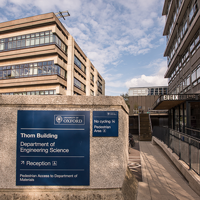Photonic Devices
Dynamic Optics and Photonics
Photonic Devices
The group’s adaptive laser-based manufacturing techniques are useful for manufacturing a range of photonic devices.
Our work in this area involves collaborations with the Soft Matter Photonics research group and the Ion Trap Quantum Computing research group, both at the University of Oxford. Our external collaborators include Ian Walmsley at Imperial College London, and Alexander Jesacher at the Medical University of Innsbruck.
Waveguides
An important application is laser-written waveguides in glass, where the laser induces a local increase in the refractive index of the glass substrate. This can be used to trace out an optical waveguide, analogous to the core of an optical fibre, in three dimensions.

Ultrashort pulses from a 515nm laser focused inside a block of glass
to form optical waveguides at different depths.
Adaptive optics is used for dynamic control over the waveguide cross-section, enabling the production of adiabatic mode converter devices, as well as aberration correction deep inside the glass, allowing the production of large photonic lattices. These devices create many new possibilities in quantum technologies and optical computing, and they can even cross-over to new applications in Biomedical Imaging.
Novel photonic devices
We have extended our work in the fabrication space to also create large aperiodic photonic volume elements. In these devices, large volumes contain many 'voxels', which are akin to small segments of waveguide. Such devices are used for angular and wavelength multiplexing of incident light fields. They have applications in information processing, spectroscopy, telecommunications, and any application that benefits from controlling the flow of light.

A 3d array of laser written voxels in glass for shaping incident light fields.
We also use two photon polymerisation with a liquid crystalline resin to create a range of simple and compact, yet tuneable, photonic devices. These have applications ranging from optical microscopes through to mobile phone cameras. Further liquid crystal technology is used to reduce laser speckle in visual displays, and adaptively control the coherence of light, for various technological applications including imaging and manufacturing. This research is carried out in close collaboration with the Soft Matter Photonics Group at the University of Oxford.
Our work in this area overlaps with our research in Microscopy and the Vectorial Optics and Photonics (VOP) group.
Publications
On-chip beam rotators, adiabatic mode converters, and waveplates through low-loss waveguides with variable cross-sections
Bangshan Sun, Fyodor Morozko, Patrick S. Salter, Simon Moser, Zhikai Pong, Raj B. Patel, Ian A. Walmsley, Mohan Wang, Adir Hazan, Nicolas Barré, Alexander Jesacher, Julian Fells, Chao He, Aviad Katiyi, Zhen-Nan Tian, Alina Karabchevsky & Martin J. Booth Light Sci Appl 11, 214 (2022)
3D Switchable Diffractive Optical Elements Fabricated with Two-Photon Polymerization
John Sandford O'Neill, Patrick Salter, Zimo Zhao, Bohan Chen, Hassan Daginawalla, Martin J. Booth, Steve J. Elston & Stephen M. Morris Advanced Optical Materials 10, 7 (2022)
Laser-Written Tunable Liquid Crystal Aberration Correctors
Alec Xu, Camron Nourshargh, Patrick S. Salter, Chao He, Steve J. Elston, Martin J. Booth & Stephen M. Morris ACS Photonics 10, 9, 3401–3408 (2023)
Direct laser-written aperiodic photonic volume elements for complex light shaping with high efficiency: inverse design and fabrication
Nicolas Barré, Ravi Shivaraman, Simon Moser, Patrick Salter, Michael Schmidt, Martin J. Booth, Alexander Jesacher Advanced Photonics Nexus 2, 3, 036006 (2023)
Photonic Topological Mode Bound to a Vortex
Adrian J. Menssen, Jun Guan, David Felce, Martin J. Booth & Ian A. Walmsley Phys. Rev. Lett. 125, 117401 (2020)










